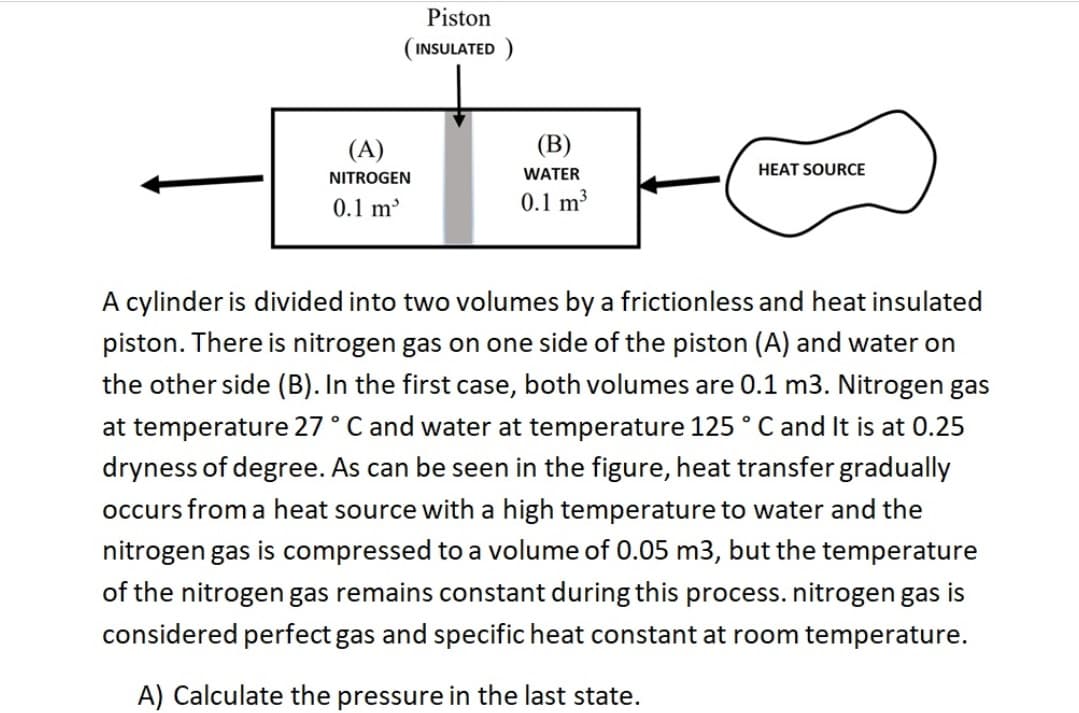A cylinder is divided into two volumes by a frictionless and heat insulated piston. There is nitrogen gas on one side of the piston (A) and water on the other side (B). In the first case, both volumes are 0.1 m3. Nitrogen gas at temperature 27 ° C and water at temperature 125 ° C and It is at 0.25 dryness of degree. As can be seen in the figure, heat transfer gradually occurs from a heat source with a high temperature to water and the nitrogen gas is compressed to a volume of 0.05 m3, but the temperature of the nitrogen gas remains constant during this process. nitrogen gas is considered perfect gas and specific heat constant at room temperature. A) Calculate the pressure in the last state.
A cylinder is divided into two volumes by a frictionless and heat insulated piston. There is nitrogen gas on one side of the piston (A) and water on the other side (B). In the first case, both volumes are 0.1 m3. Nitrogen gas at temperature 27 ° C and water at temperature 125 ° C and It is at 0.25 dryness of degree. As can be seen in the figure, heat transfer gradually occurs from a heat source with a high temperature to water and the nitrogen gas is compressed to a volume of 0.05 m3, but the temperature of the nitrogen gas remains constant during this process. nitrogen gas is considered perfect gas and specific heat constant at room temperature. A) Calculate the pressure in the last state.
Elements Of Electromagnetics
7th Edition
ISBN:9780190698614
Author:Sadiku, Matthew N. O.
Publisher:Sadiku, Matthew N. O.
ChapterMA: Math Assessment
Section: Chapter Questions
Problem 1.1MA
Related questions
Question
can you solve the question

Transcribed Image Text:Piston
INSULATED
(A)
(B)
NITROGEN
WATER
HEAT SOURCE
0.1 m'
0.1 m3
A cylinder is divided into two volumes by a frictionless and heat insulated
piston. There is nitrogen gas on one side of the piston (A) and water on
the other side (B). In the first case, both volumes are 0.1 m3. Nitrogen gas
at temperature 27 ° C and water at temperature 125 ° C and It is at 0.25
dryness of degree. As can be seen in the figure, heat transfer gradually
occurs from a heat source with a high temperature to water and the
nitrogen gas is compressed to a volume of 0.05 m3, but the temperature
of the nitrogen gas remains constant during this process. nitrogen gas is
considered perfect gas and specific heat constant at room temperature.
A) Calculate the pressure in the last state.
Expert Solution
This question has been solved!
Explore an expertly crafted, step-by-step solution for a thorough understanding of key concepts.
Step by step
Solved in 2 steps with 4 images

Knowledge Booster
Learn more about
Need a deep-dive on the concept behind this application? Look no further. Learn more about this topic, mechanical-engineering and related others by exploring similar questions and additional content below.Recommended textbooks for you

Elements Of Electromagnetics
Mechanical Engineering
ISBN:
9780190698614
Author:
Sadiku, Matthew N. O.
Publisher:
Oxford University Press

Mechanics of Materials (10th Edition)
Mechanical Engineering
ISBN:
9780134319650
Author:
Russell C. Hibbeler
Publisher:
PEARSON

Thermodynamics: An Engineering Approach
Mechanical Engineering
ISBN:
9781259822674
Author:
Yunus A. Cengel Dr., Michael A. Boles
Publisher:
McGraw-Hill Education

Elements Of Electromagnetics
Mechanical Engineering
ISBN:
9780190698614
Author:
Sadiku, Matthew N. O.
Publisher:
Oxford University Press

Mechanics of Materials (10th Edition)
Mechanical Engineering
ISBN:
9780134319650
Author:
Russell C. Hibbeler
Publisher:
PEARSON

Thermodynamics: An Engineering Approach
Mechanical Engineering
ISBN:
9781259822674
Author:
Yunus A. Cengel Dr., Michael A. Boles
Publisher:
McGraw-Hill Education

Control Systems Engineering
Mechanical Engineering
ISBN:
9781118170519
Author:
Norman S. Nise
Publisher:
WILEY

Mechanics of Materials (MindTap Course List)
Mechanical Engineering
ISBN:
9781337093347
Author:
Barry J. Goodno, James M. Gere
Publisher:
Cengage Learning

Engineering Mechanics: Statics
Mechanical Engineering
ISBN:
9781118807330
Author:
James L. Meriam, L. G. Kraige, J. N. Bolton
Publisher:
WILEY